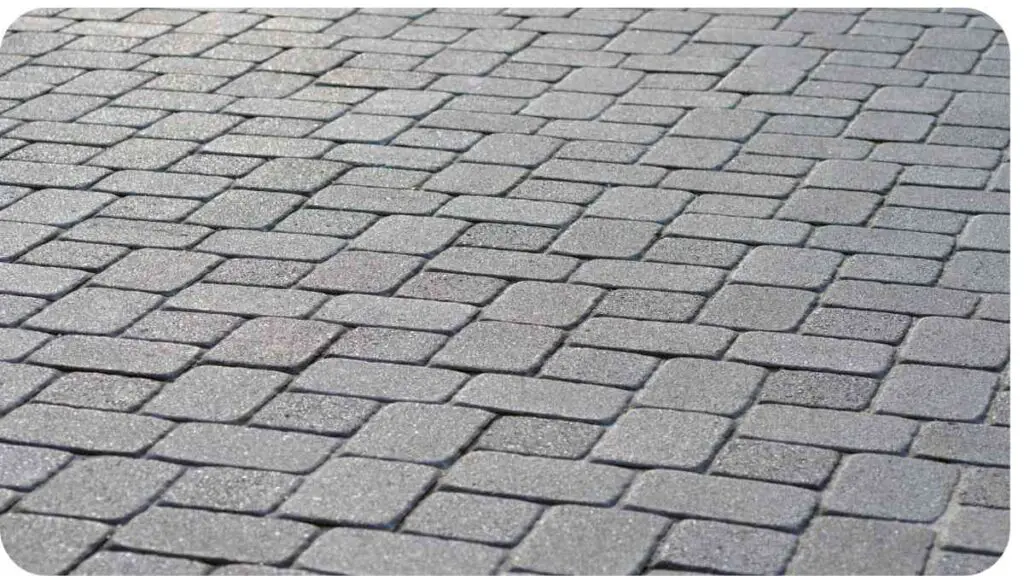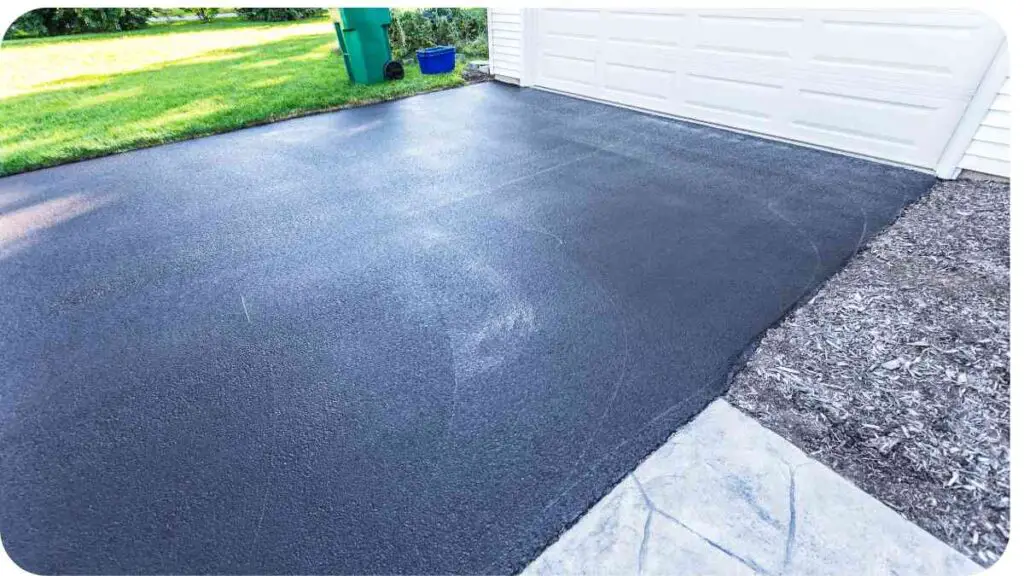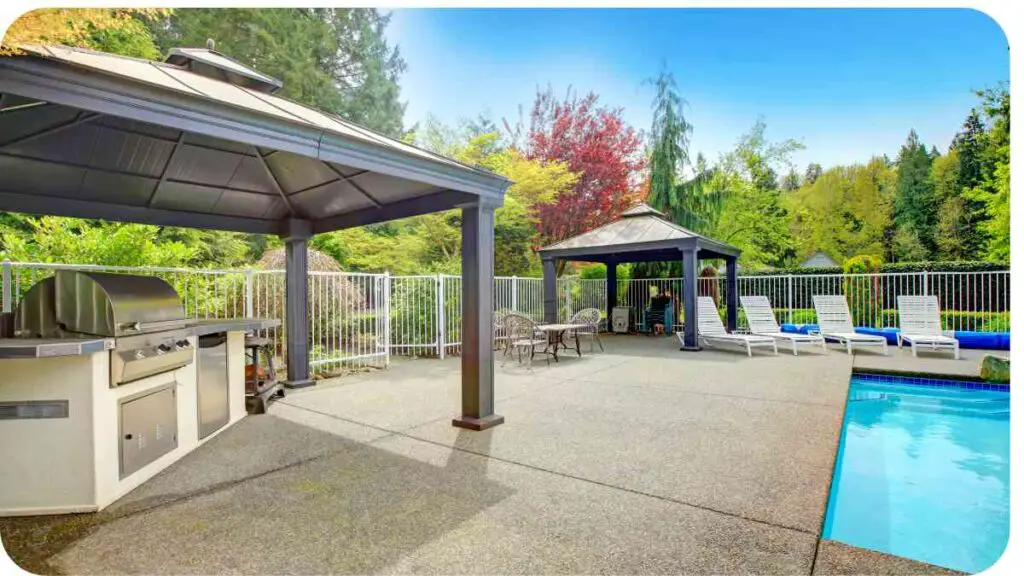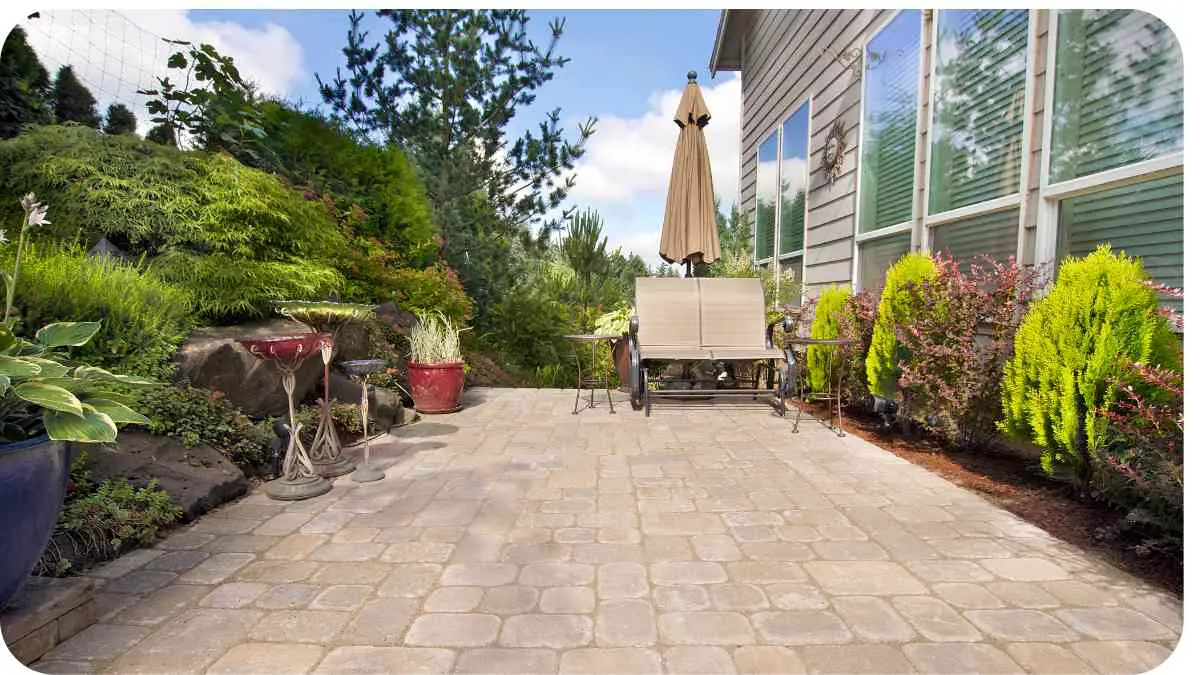Is sealing a patio hard? It’s a question many homeowners ponder as they look at their outdoor spaces. Sealing a patio can seem like a daunting task, but with the right information and tools, it becomes a manageable DIY project.
In this guide, I’ll walk you through everything you need to know about sealing your patio, from the benefits and materials needed to the step-by-step process and expert tips. Let’s dive in and make your patio the envy of the neighborhood!
| Key Takeaways |
|---|
| Sealing a patio protects it from weather damage and wear, extending its lifespan. |
| Proper preparation, including cleaning and repairing cracks, is essential for a successful seal. |
| Choose the right type of sealant based on your patio material and desired finish. |
| Apply the sealant evenly and allow adequate drying time for the best results. |
| Avoid common mistakes like overapplication and ignoring weather conditions. |
| Regular maintenance, including resealing every few years, keeps your patio looking great. |
| DIY sealing is cost-effective but requires time and effort; professional services offer convenience and expertise. |
| Consider seasonal conditions when planning to seal your patio for optimal results. |
Understanding Patio Sealing

What is Patio Sealing?
Patio sealing involves applying a protective layer over your patio surface to shield it from weather damage, stains, and wear. Think of it as putting a raincoat on your patio it helps keep it looking new and vibrant for years.
To maintain your patio’s longevity, it’s crucial to understand how often you should seal a concrete patio. Discover the best practices in this guide. Regular sealing helps protect your investment from wear and tear.
Why Seal a Patio?
Sealing a patio is essential for maintaining its beauty and longevity. Without sealing, your patio is vulnerable to the elements, which can lead to cracks, discoloration, and deterioration. By sealing your patio, you protect your investment and ensure it remains a pleasant space for outdoor activities.
Materials Needed for Sealing a Patio
Sealant Types
There are various types of sealants available, each suited for different materials and desired finishes. Here are some common ones:
| Sealant Type | Suitable For | Finish |
|---|---|---|
| Acrylic Sealers | Concrete, Stone | Glossy, Matte |
| Penetrating Sealers | Brick, Porous Surfaces | Natural Look |
| Polyurethane Sealers | High-Traffic Areas | Durable, Clear |
Tools and Equipment
To seal your patio, you’ll need the following tools and equipment:
| Tool/Equipment | Purpose |
|---|---|
| Pressure Washer | Cleaning the patio surface |
| Crack Filler | Repairing any cracks |
| Paint Roller/Brush | Applying the sealant |
| Protective Gear | Ensuring safety during the process |
Preparing Your Patio for Sealing
Cleaning the Surface
Before sealing, it’s crucial to clean your patio thoroughly. Use a pressure washer to remove dirt, grime, and any existing sealant residue. A clean surface ensures the sealant adheres properly and provides maximum protection.
Protecting your patio furniture from winter weather is essential for extending its life. Learn effective strategies and tips in our article on how to protect patio furniture. Don’t let harsh conditions damage your furnishings.
Repairing Cracks and Gaps
Inspect your patio for any cracks or gaps and fill them with a suitable crack filler. This step prevents water from seeping in and causing further damage. A smooth surface also makes for a more uniform sealant application.
Step-by-Step Guide to Sealing a Patio

Applying the Sealant
- Choose the Right Day: Select a day with mild weather ideally, dry and not too hot.
- Apply the Sealant: Using a paint roller or brush, apply the sealant evenly across the patio surface. Ensure you cover all areas, including edges and corners.
- Let it Dry: Allow the first coat to dry according to the manufacturer’s instructions.
Drying and Curing Time
After applying the sealant, it’s important to let it dry completely. This can take anywhere from a few hours to a full day, depending on the sealant type and weather conditions. Ensure the patio remains undisturbed during this period.
Repairing outdoor patio furniture can be a straightforward process if you know the right methods. Find practical solutions for fixing common issues in our guide on how to fix outdoor patio furniture. Restore your furniture to its former glory.
Second Coat and Maintenance
For added protection, consider applying a second coat of sealant once the first one is dry. Regular maintenance, such as cleaning and resealing every few years, will keep your patio in top shape.
Common Mistakes to Avoid
Overapplication of Sealant
Applying too much sealant can lead to a sticky surface and uneven drying. Follow the manufacturer’s guidelines for the right amount.
Ignoring Weather Conditions
Weather plays a crucial role in sealing success. Avoid sealing on rainy or extremely hot days, as these conditions can affect the sealant’s performance.
Benefits of Sealing Your Patio

Enhanced Durability
Sealing your patio extends its lifespan by protecting it from moisture, UV rays, and everyday wear and tear.
If you’re planning a patio upgrade, knowing the cost is crucial. Get a detailed breakdown of expenses for a 20×10 paver patio in our article, How Much Does a 20×10 Paver Patio Cost?. Make an informed decision before starting your project.
Improved Aesthetics
A sealed patio looks polished and well-maintained, enhancing your outdoor space’s overall appeal.
Cost Analysis
DIY vs. Professional Sealing
Sealing your patio yourself is cost-effective but requires time and effort. Hiring a professional ensures a high-quality finish but comes at a higher cost.
Breakdown of Costs
| Expense | DIY Cost | Professional Cost |
|---|---|---|
| Sealant | $50-$100 | Included |
| Tools and Equipment | $50-$200 | Included |
| Labor | Free | $300-$500 |
Expert Tips for Successful Sealing
Choosing the Right Sealant
Select a sealant that matches your patio material and desired finish. Consult with experts or store personnel if unsure.
Seasonal Considerations
Seal your patio during dry seasons to avoid rain interfering with the drying process. Spring and fall are often ideal.
Sealing a canopy can be essential for maintaining its durability and appearance. For a comprehensive guide on this process, check out our detailed article on how to seal a canopy. Ensure your canopy remains effective and attractive.
Frequently Asked Questions
How Often Should I Seal My Patio?
It’s generally recommended to reseal your patio every 2-3 years, but this can vary based on the type of sealant used and local weather conditions.
Can I Seal My Patio Myself?
Absolutely! With the right tools and preparation, sealing a patio is a manageable DIY project.
What if It Rains After Sealing?
If it rains before the sealant dries, it can wash away or damage the application. Check the weather forecast and choose a dry period for sealing.
How Long Does Sealing Last?
A good sealant can last up to 5 years, but factors like heavy usage and harsh weather can shorten this period.
Is Sealing Necessary for All Types of Patios?
While not all patios require sealing, it is highly recommended for materials like concrete, stone, and brick to prolong their lifespan and maintain their appearance.
Conclusion
Sealing a patio may seem challenging, but with the right approach, it can be a rewarding DIY project. By following this guide, you’ll protect your patio, enhance its appearance, and enjoy a beautiful outdoor space for years to come. So, roll up your sleeves and get ready to seal your patio like a pro!
Further Reading
For those looking to dive deeper into patio sealing, here are some recommended resources:
- Should I Seal My Patio?
Learn about the benefits and considerations of sealing your patio from the experts at The Paving Experts. - How to Seal a Patio
Prime Thorpe Paving offers a comprehensive guide on sealing your patio, including step-by-step instructions. - How to Seal Paving Stones
Western Interlock provides detailed tips on sealing paving stones to ensure long-lasting durability and appearance.
FAQs
Is it hard to seal a patio yourself?
Sealing a patio yourself can be straightforward if you follow the proper steps and use the right materials. It’s a manageable DIY project for most homeowners.
How long does it take to seal a patio?
The time required to seal a patio depends on the size of the area and the type of sealant used. Generally, it can take a few hours to a full day, including drying time.
What type of sealant is best for a concrete patio?
Acrylic sealers are commonly used for concrete patios due to their durability and range of finishes, from glossy to matte.
Can I seal a patio in cold weather?
Sealing a patio in cold weather is not recommended as low temperatures can affect the sealant’s effectiveness and drying time. Aim for mild, dry weather conditions.
How often should I reapply sealant to my patio?
It’s recommended to reapply sealant every 2-3 years to maintain protection and appearance, though this can vary based on environmental factors and usage.

I am Hellen James, a professional handywoman with expertise in improving home and garden spaces by using pergolas, gazebos, and tents.

